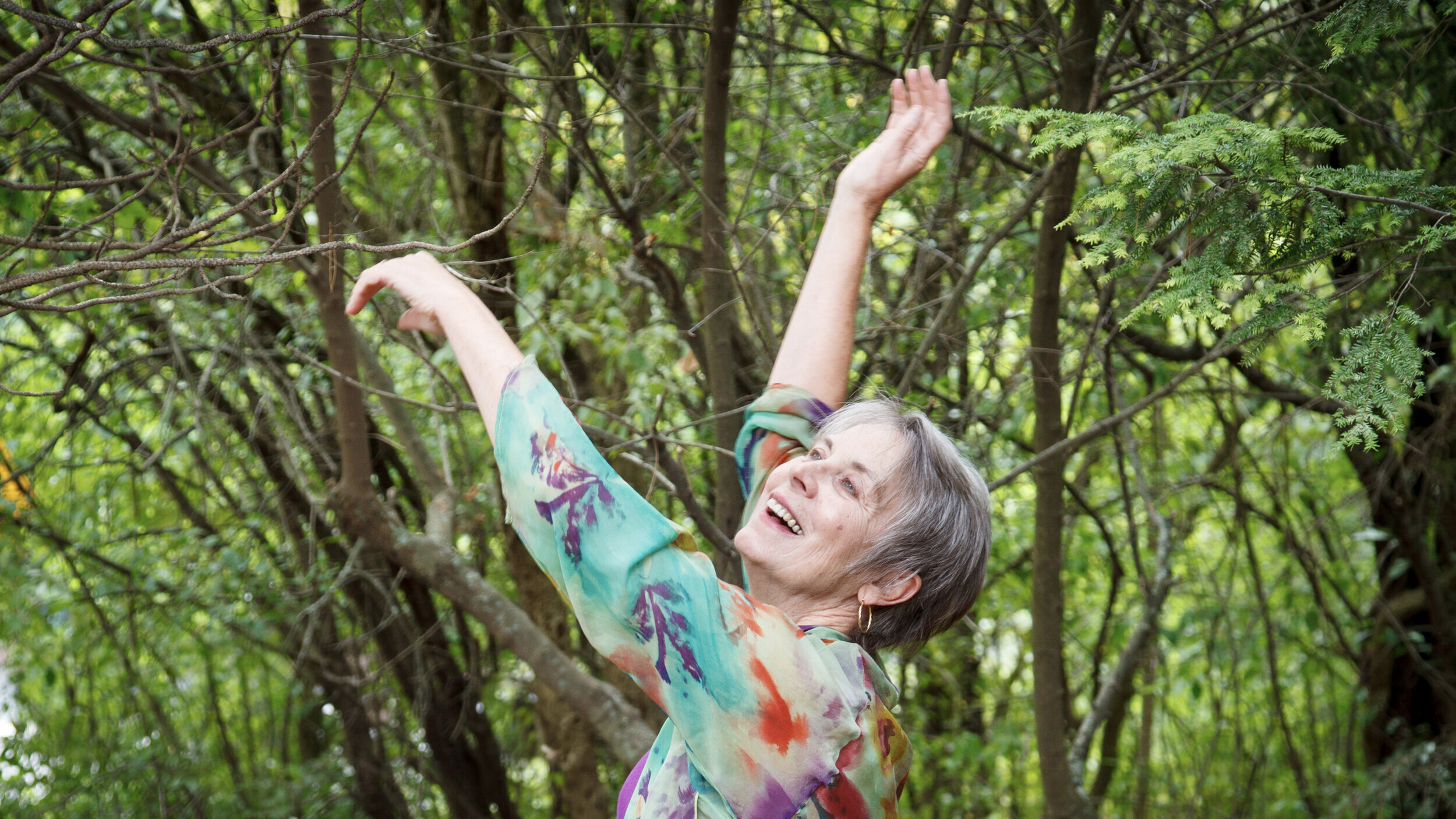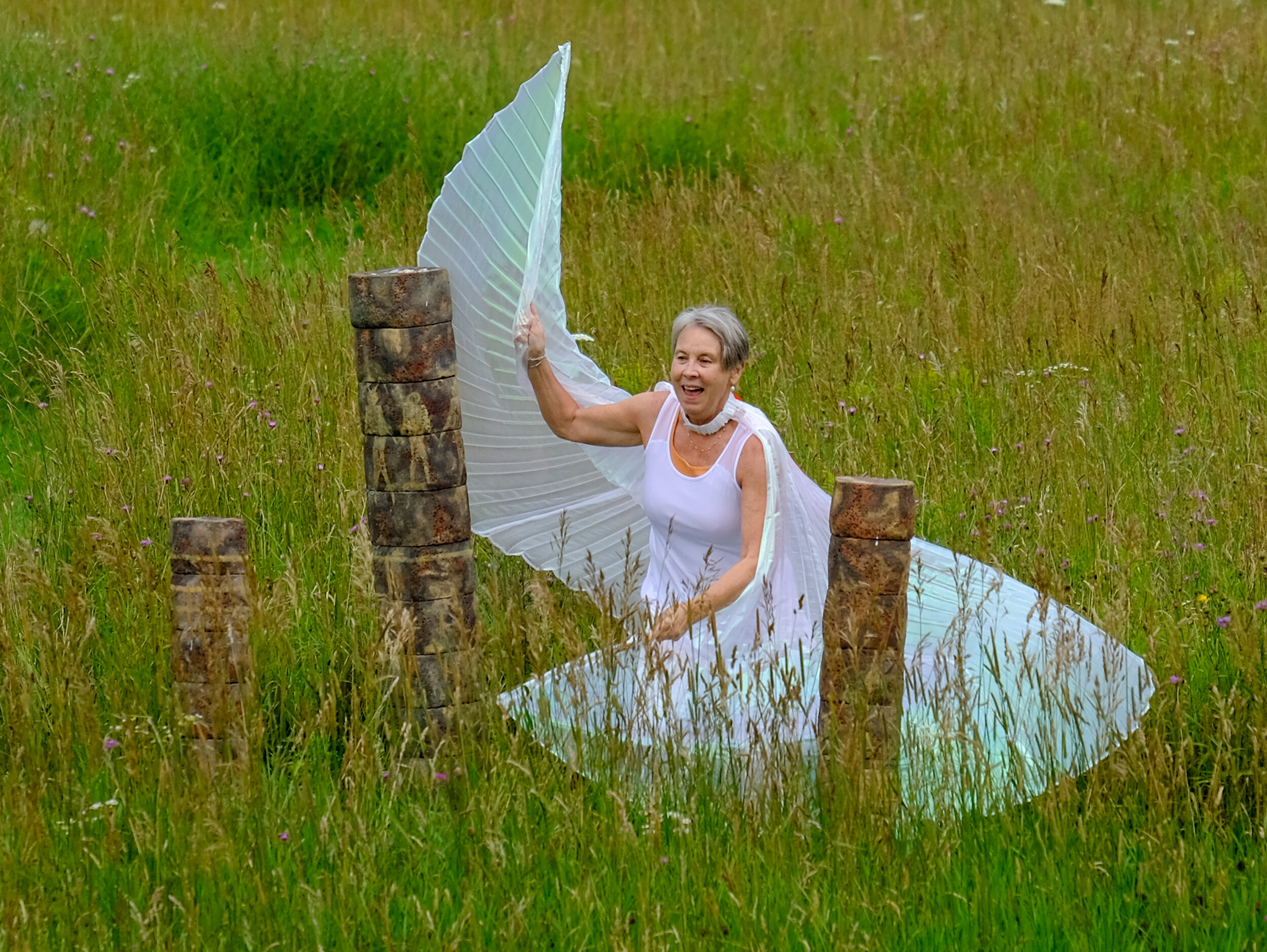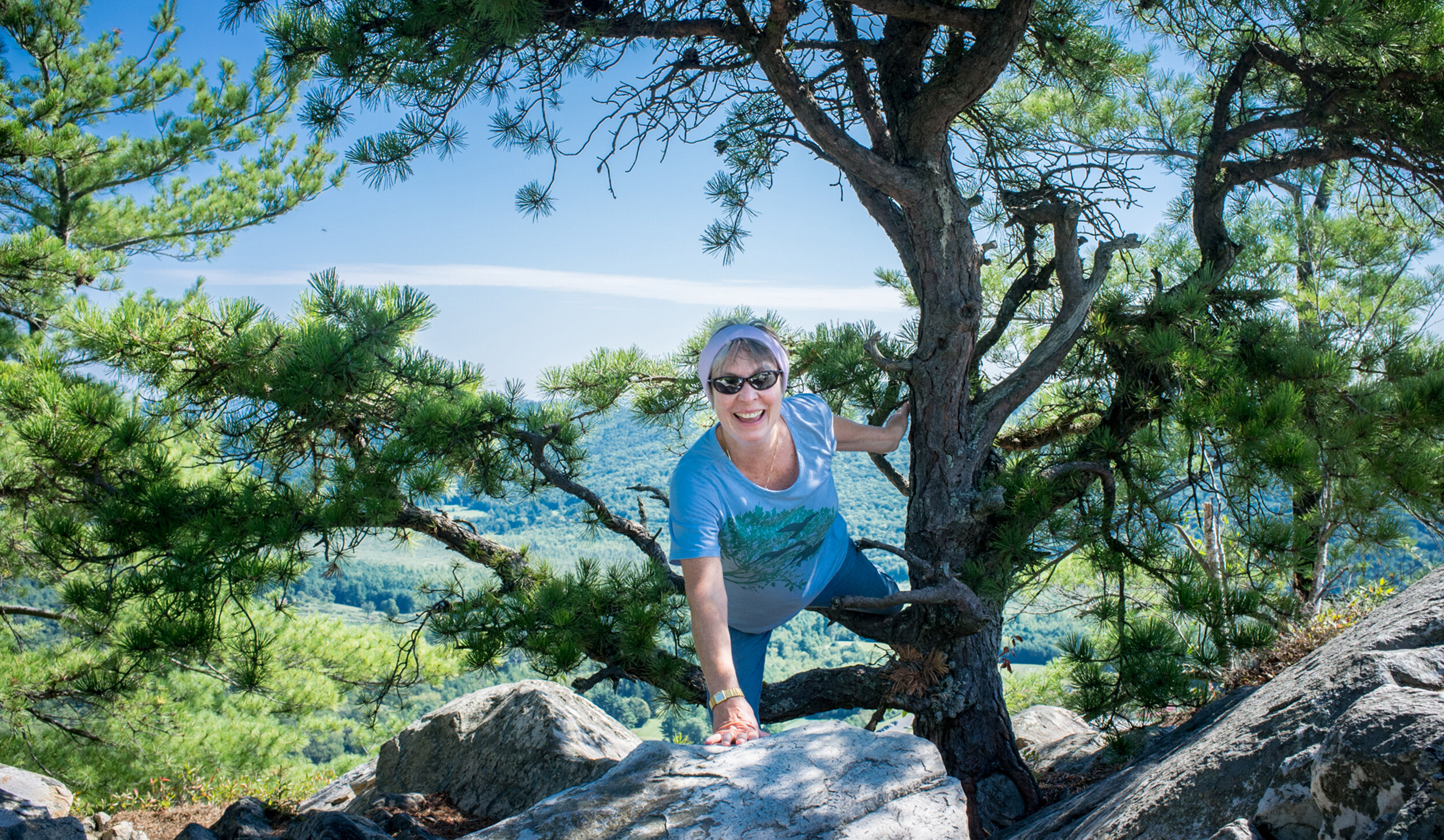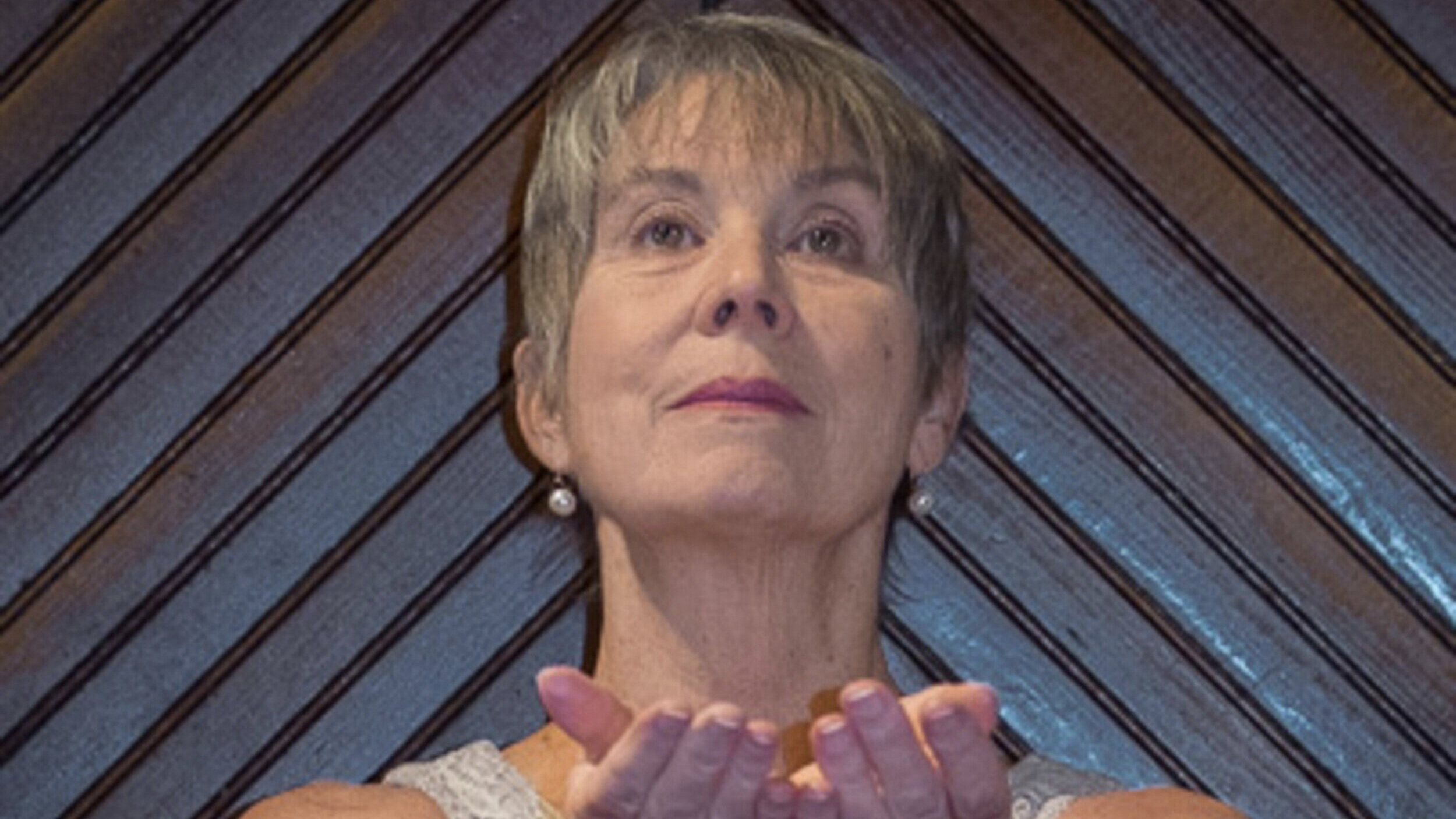Deborah Welsh
Nicolás Dumit Estévez Raful Espejo: Deborah, it is a pleasure to continue our conversation through this Q&I. I became aware of you while studying at Copper Beech Institute. It was a strange situation because I ran away, literally, from the main workshop that week — right in the middle of it — yet the class that you taught as an extracurricular activity stayed with me. Would you say something about what you presented to us in terms of dance?
Deborah Welsh: Thank you Nicolás. It was my pleasure to meet you ever so briefly, and in a crowd, when we were at the retreat. Your presence was noted though, and I remember you fondly. The program I presented was titled “The Dance of Divine Presence.” Those, like yourself, who bring their own full presence into the work at hand are always treasured. In addition to mine, there were three other options for movement in the early afternoon each day: T’ai Chi, Yoga, and Body Prayer. These sessions were to have been integrated into the main teaching material, but that wasn’t the case, so that they indeed became “extracurricular,” much to my frustration. This typically happens in contexts where the body and movement are deemed secondary to the so-called “important” and usually more heady and non-body oriented material and practices.” Of course, I don’t buy that!
In each of my sessions I shared from four different areas of my expertise to enhance bodymind presence. My background in this work stretches back forty years to include Early Modern to Mid-century Dance, Gestural Praying through Movement and Dance, Authentic Movement, and Meditative Stillness.
NDERE: I commend Copper Beech’s support when I chose to leave the workshop for which I signed up. Their staff was really present when I decided to confront an instructor who, I thought, responded to me in a way that reinforced white privilege and systemic racism. I am glad that I returned to Copper Beech and had a very positive experience at Leslie Booker’s retreat. All of this is being mentioned because I felt that your class took us right into the body, a contested territory in the U.S. context. Can you talk about the body in the realm of Sacred Dance and Dance of Divine Presence? And before that, can you explain Sacred Dance and what you refer to as Dance of Divine Presence?
DW: Again, I thank you, Nicolás, for “getting it.” I have a pretty vast definition of the sacred. Generally, I believe that any action has the potential to be experienced as sacred, even the smallest and most normative gesture. It can be in both the experience of the mover and/or in the eyes and heart of the beholder. My first experience dancing in this realm was like a lightning bolt. I thought I was taking a typical dance workshop and soon realized “something else” happened to me. This was in Anna Halprin’s work in the late 1970s. I lovingly call it my dance “conversion” experience. I set out from there to understand what happened, and that took me back to school for doctoral work to research and explore this phenomenon both intellectually and through my body. In addition I taught dance at Syracuse University, which was a great laboratory for the work. My dissertation advisor was in the Religion Department, and it was in that research that I discovered religious historian, Mircea Eliade and C.G. Jung. In his little book The Sacred and the Profane, Eliade writes that the sacred is that which “founds the world.” To me that said it all. THAT’S what I experienced. I founded a sacred world in my deep presence to the dance and it connected me to ALL.
NDERE: What would you say makes Sacred Dance sacred? My understanding is that all dance, like all art, originally served to connect with the Divine. Are you pointing in this direction and taking us back to the very roots of movement?
DW: I would say, without a doubt, that it is the “connection,” and that it is no ordinary connection. It is mystical and beyond rational thought and understanding—transcendent. It is a felt sense of union with all there is. Call it God, the Divine, Love. In dance this can happen quite spontaneously in improvisation or when a technical dance is so embodied that it transcends ordinary, more rote, experience. As audience, we “know” when that transcendence happens in performance and when it doesn’t. We ourselves become energetically part of it when it does happen. When a dance performance is technically brilliant but “nobody’s home” so to speak, we appreciate the technique, but it does not transcend itself. And many readers may relate this to other creative endeavors or experiences in nature.
As for dance history, Nicolás, yes, the earliest dance we know of served to connect human experience to the unknown, to “other.” The hunter became the deer. The gatherer became the essence of the tree. The rhythm, the dance, the drawings, the songs were all of a piece to approach the great unknown for survival.
NDERE: Matthew Fox has come up with the idea of a Cosmic Mass that re-integrates dance into spirituality; that reclaims dance as sacred. Fox uses Rave music and visuals as part of a liturgy that includes, of course, the Eucharist. In your case, you have come up with a series of movements that you refer to as Prayer of Movement and Gesture. Tell me more about these.
DW: Your mention of Matthew Fox brings a smile. I read On Becoming a Musical, Mystical Bear: Spirituality American Style (1972) years ago and loved it at a time when I was in a personal shadowy place. I haven’t followed Fox, so I’m happy to know he dances! Those kinds of ecstatic dance events where there’s lots of room and great music to let loose are incredibly soul nourishing!
The Prayer of Movement and Gesture that I simply call “The Moving Prayer,” originated organically and collectively in an ongoing workshop I created called “Wisdom of the Body.” I was invited to do this as a part of a contemplatively progressive Episcopal parish’s ministry. The priest who invited me to do it, Bill Redfield, subsequently integrated my work into the Wisdom School Retreats he and Sister of St. Joseph, Lois Barton, were funded to lead. This prayer was a staple in the retreats each day. There is a detailed link to it with photographs on my website: under Offerings/Wisdom of the Body. The prayer consists of simple gestures done in a sequence beginning with a two gesture invocation, and six simple, universal gestures that are usually done successively three times, coordinating the last time with the chant, “Be still and know that I am God.” Of course it can be done any number of times and with one’s own variations, chants, vocal prayers, or silence. I have done versions of it as parts of Centering Prayer sessions, in Eucharist and Holy Week services, at a priest’s ordination, Sister Lois’ Golden Jubilee mass, and a memorial service for an artist/priest. I am always very happy to meet people years later who tell me they practice the prayer and that they’ve shared it with many others.
As I mentioned earlier, what makes any prayer sacred is allowing the flow of the gestures—just as in word—to move beyond “going through the motions” to a sense of connection to the Divine. Of course one can’t automatically “make” that happen. There is a discipline though to learning a sequence of gestures and knowing them in the body so well that, as in meditation or Centering/Welcoming Prayer, we “let go.”
NDERE: You also engage in Authentic Movement, a practice founded by C.G. Jung. Can you give me an insight into this and illuminate how you bring Authentic Movement into your day?
DW: Yes. I have been practicing Authentic Movement for a very long time and before that, Anna Halprin’s Self Portraiture. Authentic Movement is a powerful form for both spiritual and psychological work, as is the Self Portrait. Authentic Movement is derived from C.G. Jung’s Active Imagination where he writes that some may dance their experiences while others may draw, write, etc. Specifically, Authentic Movement was founded by Mary Whitehouse, an early Dance Movement Therapist. There is a specific dyadic structure to it and it needs to be practiced in relation to a skilled “witness” to one’s unfolding authentic “mover.” The non-judging witness is ultimately united within the mover’s own experience potentially in dances of wholeness and connection. My sacred dance doctoral work was framed in Jung’s psychology and symbolism which led me to become a Licensed and Board Certified Dance Movement Therapist where I conducted many Authentic Movement groups and workshops.
As for bringing Authentic Movement into daily life, as in any contemplative spiritual practice, as well as psychotherapy, the deepest work is only truly effective when it is integrated into every moment, not done only when specifically engaged in the form. The key concept here is AUTHENTIC. We must learn to be and accept who we truly are: our foibles and failures, as well as our successes and joys. We do these practices to develop, know, love and trust all of who we are….
NDERE: I practice Prayer of Movement and Gesture before going to bed at night and when I get up in the mornings. Can you help me better understand where this and Dance of Divine Presence might overlap and inform one another, and how I might integrate them into the sacred dance that can be the day-to-day?
DW: I may have answered that question in my comments above. The key is not so much in “that” you practice the prayer, but “how.” That is, how present and authentic are we in our dance of the prayer? Do we join with that which is the ALL of humanity, the Divine? I’ve been studying The Cloud of Unknowing, the 14th century anonymous monastic text, and the challenge is in the intention of our work to “forget” who we think we are and enter a deep unknowing “naked intent to God” through which in our prayer, study, and community we are possibly “known” with God. It is a very personal experience of awesome presence—of being seen, acknowledged, known. For some of us, dance is a vehicle for glimpses through that cloud.
NDERE: I was born in the Dominican Republic, where dance has a central role in our lives. Many of us connect dance to almost every activity we do. For example, some people there could not foresee cleaning their homes without having music with which to combine mopping and sweeping motions to Merengue or Bachata steps. In the Dominican Republic babies are encouraged to dance from a very early age. You are a Jungian Doctor, so I am wondering if you could share some thoughts as to the role of dance and movement in healing. I am thinking about this as we go through the Covid-19 pandemic.
DW: Ah, dance as healing! YES. One of the best parts of spontaneous or improvisational dance is the letting go, the release into that which potentially relieves suffering. The same thing is true when we fully know a pattern and surrender to it. Sacred dance historically has been simple, repetitive steps, often in the case of very primal dance, lasting for hours or days, or as for Dominicans and other cultures, permeating much of daily life. Rhythm is healing, and dance, even those dark and difficult dances, bring us to a very special kind of pleasure as we accept and dance through that which is.
Many years ago when I was teaching dance, I had a very difficult bout of mononucleosis and was sick for a long time. During my recovery, I did many self-portraits starting completely immobilized in a heap on the ground. Many dances barely moved at all. Gradually, as I got well my dance was a barometer of my recovery as I gradually rose to my feet and moved into the space around me. The dancing gave me the healing connection with the Divine we spoke of earlier.
One of my professional accomplishments was to found Dance Therapy programs in two local psychiatric hospitals. It never ceased to delight me to see nearly catatonic, often highly traumatized and medicated patients, come to life with smiles and personal interactions in the groups. Dance enhances mood as well as gets the blood flowing, muscles working, and the most basic connections manifested. All of that may just lead to something deeper—to the sacred
NDERE: Thinking of babies and taking this further, I would say that all life is dance. Take conception as an example: the interaction of the egg and the sperm. I am actually taking a class with Bonnie Bainbridge Cohen in which she talks about the egg in regards to dance, metaphorically speaking, as pausing and entering reflection; and the sperm as engaging in movement and activity. But Bonnie clarifies that the egg is actually the one who “opens the door” for the sperm to come in, and in this sense has the last word! I love that. But I have gone off on a tangent. My question is about life and dance and life being a continuous dance.
DW: It is true, Nicolás. Movement reconciles opposites—as in Bonnie’s example. Another way is at the level of muscles working together: one muscle contracts while the opposite stretches. When we breath our bodies expand on the inbreath and contract on the outbreath. That feeling of getting bigger and smaller with each breath is amazing. As you say we: move/pause, advance/retreat, open/shut, etc. Importantly in dance there is also a symbolic flow of the tension of opposites in relation to a topic, relationship, or gesture. Our spiritual task is to recognize and work with how deadly it can be to get caught in the dualism, when we are either completely stuck, or so frenetic there is only one extreme or the other. The sacred, and also the artistic, is lost either way. Yet holding the “both/and” while freely moving between the extremes is the incredible “still point,” as T.S. Eliot tells us is “where the dance is.”
NDERE: I feel that I could talk dance with you for a long time. There is dance we as babies most likely perform as we swim in our mothers’ wombs. You and I have studied with Anna Halprin. She just turned 100. What are her influences in what you do and what have you done with her message? I am asking because Anna is big on acknowledging all aspects of the person, including spirit, and because of your focus on the sacred in dance.
DW: Anna Halprin was my first true dance teacher. I had taken many dance classes, but only starting as a young adult. I don’t consider myself a technically trained dancer. It was Anna’s work that inspired me to KNOW dance as depth and that technique is the honing of the instrument like having a well-made cello to play. The purpose of technique is not to acquire skill for the sake of it, but to put its hard-earned benefits to use for a deeper, greater, and more abundant expression of truth in the world. When I witness someone truly dance from the heart, even the most physically or emotionally limited person, I know that I have carried Anna’s legacy onward along with the other early Modern Dancers like Ruth St. Denis and Martha Graham, through the lineage to Anna. She is a wise woman who knows dance not only as performance, but also as healing, community, and power. I will be forever grateful to her for my own awakening, and for her personal blessing on me to carry forward on my own creative path.
NDERE: Would you guide us into a simple dance with life? Perhaps you could give us some directions or steps that we can elaborate on?
DW: I think of this Rumi quote:
“Dance, when you're broken open. Dance, if you've torn the bandage off. Dance in the middle of the fighting. Dance in your blood. Dance when you're perfectly free.”
The thing is dance itself frees us! So begin with a first step, a gesture, enact an image or allow an emotion to be fully expressed in the body. Call that your dance. Name it so. We dance by beginning to recognize dance in life through awareness of our movement and gestures, as meaning making, as connecting, and as potentially sacred within that connection.
I loved what you said about the Dominican culture and music and dancing that riffs on traditional art forms. YES! A mop, a dust rag, a chair--all terrific partners! When out for a walk, play with the steps maybe in waltz or samba tempo, add a little leap over a puddle, twirl around and catch some snowflakes in open palms, use the swimming pool as dance studio, etc.
Mostly, start simple and do what nourishes the soul. You may find the joy and depth in a disciplined dance structure, but short of a particular form or training option: improvise! Make your own dance. And with that “naked intent to God,” it becomes sacred.
NDERE: I thank you for this and I hope to dance with you in a wide field or forest in Central New York State, a place I was connected to for 14 years. But now I will dance to the script above.
DW: One thing that I trust more than any other in sacred dancing is that each of us KNOWS our dance and we simply have to follow the invitation to dance it. Each and every dance is a gift to the universe and so I encourage you, and all your readers, to just dance! I look forward to dancing with you here in beautiful Central New York, or in your vibrant city, dear Nicolás, when the time is right. Thank you for the opportunity to share these thoughts and reminiscences.
Photos: Bob Gates
Deborah Welsh is a retired Licensed Creative Arts Therapist, Board Certified Dance/Movement Therapist, a licensed Mental Health Counselor, and Advanced Teacher of yoga nidra/iRest ©. Currently, her professional focus is on Sacred Dance and contemplative practices of non-dual, integrative spirituality, particularly within the traditions of Christianity and Buddhism. She leads workshops and sessions in a program she developed titled “Wisdom of the Body,” (see below) primarily within the Wisdom Schools and Retreats of Wisdoms Work (www.wisdomswork.com). Additionally, she founded The Sacred Dance Collective of Central New York, a group of dancers exploring the power of dance as a medium of prayer, contemplation, and social action.
Deborah has been teaching dance and movement for over forty-five years and practiced psychotherapy for over thirty years, with a wide variety of people and in many settings. Her theoretical background and training is predominantly in C.G. Jung’s psychoanalytic theories and depth psychology, with a broad knowledge of current therapy/counseling theories and practices. Creativity is the essential foundation of her work. She believes life is a creative act.
Deborah’s clinical and teaching background includes developing Dance/Movement and Creative Arts Therapy programs at the former Benjamin Rush Psychiatric Hospital and Addictions Rehabilitation Center, where she also directed the Women’s Program and led groups to address body image issues and sexual abuse and “Multi-modal” Creative Arts Therapy Programs. She developed a Dance Therapy program at Hutchings Psychiatric Center that continued with a former intern of hers. Teaching experience includes both graduate and undergraduate students at Syracuse University in the School of Education, Drama (Laban-based Movement for Actors) and Human Development Departments, and other private educational and training venues. From 1991 to December 2011, she directed the Full Circle Studio and Center for the Arts, Jungian, and Yoga Studies where she created and vetted many programs and workshops in those topics.
Wisdom of the Body is a form of Contemplative Sacred Movement and Prayer, derived in relation to the ancient Wisdom teachings that are the underpinning of the world’s religions. Wisdom of the Body is an offering in continual development that includes dance and gestural movement as prayer, the practice of the Labyrinth, and ecstatic dance. This is based in her long-standing and deep affiliation with Contemplative Christianity, Buddhism, and the yoga philosophy of Patanjali.
Within her retirement Deborah occasionally teaches programs such as Mindful Movement, yoga nidra/iRest, The Portrait Project, and Sacred Dance, in the form of workshops, retreats, study groups, and private sessions. Everything she offers, whether group or private is tailored to the physical, emotional and spiritual intentions and needs of those who participate.



